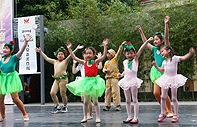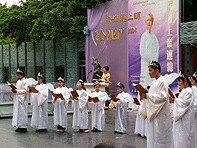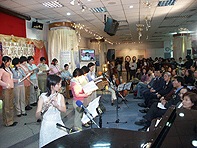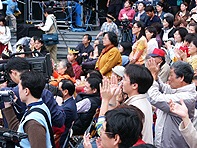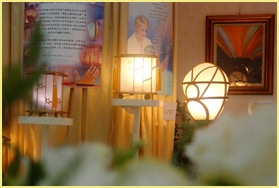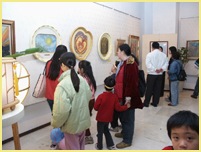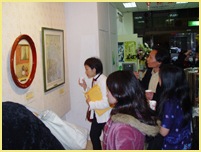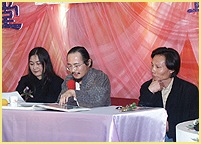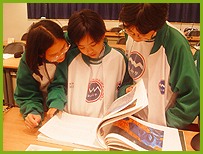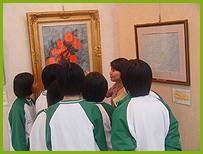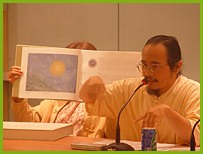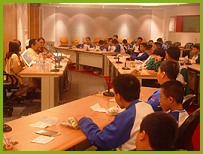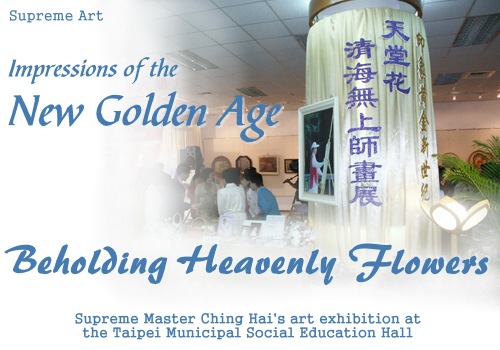
Spring has come, bringing gentle breezes that enlivened the Taipei Municipal Social Education Hall during an exhibition of Master’s paintings held by the Taipei Center from March 13 to 18, 2004. The exhibit, entitled Impressions of the New Golden Age — Heavenly Flowers, was accompanied by a series of soul-awakening activities including seminars, poetry recitations, impromptu musical performances, dances, plays and a celestial fashion show. The event awakened many Taipei residents’ long-dormant love of art, and struck a deep chord in the hearts of students from the Haishan Junior High School.

![]()
On March 13, the exhibition and its opening seminar attracted a distinguished panel of artists, art critics and poets, as well as ordinary citizens, who shared their insights and inspirations regarding Master’s paintings. Fellow initiates also expressed their sincere yearning for eternal life through moving recitations of poems from Master’s collection Silent Tears, accompanied beautifully by a harp, flute and Chinese zither in perfect harmony with the deep, mellow tones of a cello.
On the same day, a special series of activities was held on the City Stage outside the exhibition hall. First, spectacular Dunhuang dances and games for the young attracted a huge crowd of adults and children. Then thunderous drumbeats signalled the opening of an outdoor fashion show in which dozens of new SM Celestial Clothes for spring and summer were worn by fellow-initiate models, revealing Master’s unique, elegant, gracious and thoughtful designs. The models’ natural confidence accentuated the perfect cut and make of the garments and the soothing texture of the fabrics. It was no wonder that the performance drew enthusiastic rounds of applause from the audience of over two hundred.
The audience members were also highly entertained when a group of innocent young initiates presented an amusing dramatic adaptation of the story “The Chicken Prince” from Master’s illustrated book of wisdom, God Takes Care of Everything. Equally humorous was another story dramatization performed by adult initiates, “A Thief Becomes a Spiritual Practitioner.”

The exhibition’s inaugural activities created a warm atmosphere that pervaded the entire venue. As guests proceeded to the exhibition area at the Social Education Hall, they were awed by the aura of grace and brilliance radiating from Master’s paintings in a venue that already possessed a rich artistic ambiance.
A visiting artist, Ms. Li, noted how Master had captured colorful glimpses of glory from nature’s simple beauty, as demonstrated in the paintings Stone Cave and Enlightened, which evoked a deep response from her heart. She then said, “I’m enchanted by the sharp contrast between the flesh of the fruit in Mangosteen, with its pristine, mild red that instills a sense of serene calmness on the mind, and the colors in Fear, which are a realistic reflection of life.” So moved was Ms. Li that she could hardly stop singing while appreciating the paintings Mangosteen and Enlightened. She was also totally immersed in these lines from Master’s poem “Advice for Cultivating Self-Realization,” from the Wu Tzu Poems anthology: “A hundred years is nothing but a chain of upheavals,/A mix of gold and copper: difficult to know which is deception. /This life is like a water bubble on a rainy afternoon; /One should strive lest it be too late to cultivate self-realization!”
Another visitor, Ms. Huang, had learned about the art exhibition from the TV program A Journey through Aesthetic Realms, and on the event’s opening day went to The Supreme Master Ching Hai International Association’s Love Ocean Art Center in Taipei and rang the doorbell. However, the fellow initiates had all gone either to the monthly two-day retreat at Hsihu or to help out at the exhibition. But through Master’s wonderful arrangement, a sister who would normally have gone to the retreat felt an inexplicable urge to visit the Love Ocean Art Center, where she played the role of an escort, bringing Ms. Huang smoothly to the Social Education Hall. Ms. Huang was so delighted by Master’s paintings that she acquired Master’s Art Creation Album right away and lingered at the venue for five hours, feeling strong emotions as she listened to a sister explain Master’s teachings and the meaning behind Her paintings. Ms. Huang then asked without hesitation to learn the Convenient form of practice at the venue. Observing a ten-day vegetarian diet each month posed no problem for her, for she had recently developed a sudden preference for vegetarian food.
While in meditation after learning the Convenient Method, Ms. Huang was captivated by a vision of the painting Stone Cave. During this experience, an energy current drew her into a slanting cave that suddenly changed into a huge, gold colored rectangular door, which she entered without the slightest hesitation. After the meditation session, she told a sister initiate, “I really love Master’s paintings Stone Cave and Enlightened. I’m very grateful to Master for reminding me of them in my vision.” After learning the Convenient Method, Ms. Huang happily made plans to visit the Hsihu Center the following day to appreciate the rest of Master’s paintings, and also planned to adopt a full vegetarian diet and wait for initiation into the Quan Yin Method!

While the art exhibition proved enchanting for the general public, it also attracted many professional painters who came to appreciate Master’s spontaneous, innocent and likeable style. For instance, Presidential Office Advisor Huang Zhao-yuan was particularly fascinated by the painting Stone Cave, saying that it was even more avant-garde than Impressionism was in its day. “Although this painting looks complicated, one can nonetheless discern a light beam telling us that life should be happy,” he said. And for Mr. Gu Min, director of Formosa’s Legislative Yuan Library, Filled with Grace had a special appeal as it represents the highest form of bliss. “What is the state of being filled with grace?” he asked before answering himself. “It’s a kind of bliss and joy that’s only perceived by the heart and brings vibrancy to every body cell.” Director Gu Min is also a standing member of the International Federation of Library Associations and Institutions under the jurisdiction of UNESCO.
The exhibition’s organizer also invited guest artists Lin Tsang-Yuh, David Wu and Claire Chen to a seminar entitled “Afternoon Fragrance” (note 1), at which the participants analyzed Master’s paintings with great appreciation and interacted warmly with audience members. According to David Wu, creator of the Wu Jin painting method (note 2), works by naïve artists are momentary expressions of the dominant feelings at the time. The Supreme Master’s artistic style may be spontaneous, pure, innocent and direct, but She is excellent at delivering the message She wants to convey through Her works. Painting with wisdom eliminates what would have been a reliance on techniques typically found among those with formal academic training. For example, Master often uses large, bold strokes instead of going into minute details. In Her ingenious compositions, She turns complexity into simplicity with a superb command of artistic flexibility and expression through the use of shading and color contrasts.
As Mr. Wu said, “Most people undergo long rigorous training when learning to paint, but Supreme Master Ching Hai most probably uses Her wisdom, Her rich inner world, to paint. That’s why She has achieved wonderful results in such a short time,” adding that perhaps all the tools in the world are insufficient for the Supreme Master to express Her rich inner experience! Her paintings are impressionistic in style and abstract at times, but not given to details in terms of variations in light and shade. David Wu found the Supreme Master’s pastels to be no less unique than Her oil paintings. They are simple and quietly elegant, soft in expression and passionate in their use of colors.
Moreover, Mr. Wu asserted, “Supreme Master Ching Hai received no academic training, yet She skips line sketching and goes straight ahead with direct expressions in colors. Her color use is three-dimensional in perspective, featuring gradual shades of brightness. Thus, to appreciate the Supreme Master’s paintings, we may view their overall composition. It’s not necessary to take close-up looks. If we take a few steps backward, we can better feel the picture’s tension, the coordination and harmony of the colors.” In Wu’s opinion, this is the best way to appreciate Supreme Master Ching Hai’s paintings.
Artist Claire Chen pointed out that Supreme Master Ching Hai’s style is free and fluent, Her compositions intense and vibrant, completely free of restraints and reflecting absolute self-confidence. To Ms. Chen, the most significant characteristic displayed in the Supreme Master’s paintings is “letting go.” Her main artistic trait is a bold, intense style derived from innocence. She uses colors daringly and unpretentiously, revealing Her freedom from artificial traits and frills, and indicating Her great joy in painting.
Renowned artist Lin Tsang-Yuh also offered his views on the “one and only Ching Hai aesthetics” from the perspectives of art theory and philosophy, stating, “Supreme Master Ching Hai’s paintings create an impression of lightness, freedom and beauty. Stop only for a while and you will observe that, clearly expressed behind Her simple brush strokes, colors and composition is the rhythm of inner vibration and spiritual perception, full of brilliant, pristine power.” At age twenty, Mr. Lin won top prize in the Asian Youth Literary Awards competition. His creations cover a vast range of genre including novel writing, painting, photography, television script writing and directing, for which he has often received recognition. He currently teaches pastoral aesthetics at several community universities such as Taipei Wenshan Community University.
Audience member Cai Si-qin described his experiences while attending one of Lin Tsang-Yuh’s Wenshan art courses as follows: “Lin has a special way of instruction as his lessons don’t begin with sketching, which only serves to develop artistic skill. Instead, since most community university have students already acquired a rich body of life experience that they can express in their works, Lin demands that they make exploratory trials in creative expression. Only when they have difficulty in the process of creation does he step in with timely assistance. This helps students to develop their innate creative powers, and to further transcend the boundaries of traditional painting techniques. Through such unorthodox learning, they can foster their own styles. Cai Si-qin also found great inspiration for creative learning in the example of the Supreme Master, Who became expert at painting without a teacher and has found means of expression in diverse artistic styles.

On March 17, more than thirty students on an extracurricular field trip from Taipei County Haishan Junior High School visited Master’s exhibition at the Social Education Hall. Painter David Wu was invited to serve as guide and teach the youngsters to appreciate the works on display. After an initial guided tour, the students voted for their favorite paintings before touring the exhibition again in smaller groups or browsing through Master’s painting albums, all the while earnestly discussing the works with each other.
The vote revealed that the students’ favorite paintings were as follows, in the order of number of votes received: New Era, Stone Cave, The Night View of Yangming Mountain and Song of the Sea. The students also had the following insights to share: “In New Era, the pure, light colors make us feel warm and comfortable. In the upper left-hand corner, the vague image like a UFO is very mysterious, as if it’s leading us into a new era. The yellow lines covering the whole picture are as gentle as moonlight, and the tiny dots are just like stars. By imagining ourselves in the picture, we feel as if we’re being engulfed by the compassionate love of a mother. Stone Cave creates a sense of awakening. Although we don’t know what’s at the central point of the light, it seems to be penetrating time and space. By focusing on the central point, you feel as if you’re about to fly into it. In The Night View of Yangming Mountain, the cold, quiet colors on the ground and the warm, brilliant colors above create an awesome, magnificent feeling, while the brilliant rays of light give infinite hope!
Mr. Wu, surprised and delighted by the students’ brilliant remarks, said, “These comments indicate the young people’s innocent and highly imaginative hearts, and their penchant for mysticism.” He then encouraged the students to remain pure at heart so that they can develop their potential in the years to come.

Sister Ye was initiated at the age of seven and grew up in a loving Quan Yin family. She is now a university junior, with happy memories of playing with sand and lounging in a hammock in the Rainbow Garden, and of tracing Master’s footsteps and having a wonderful time with Her at the Hsihu Center. When the Taipei Center participated in the Heavenly Flowers art exhibition and in Formosa’s 2004 International Book Fair, sister Ye joined the work team for the first time, serving as a model for the spring and summer collections of the SM Celestial Clothes. Regarding these experiences, she commented, “It’s an honor and a challenge to participate in Master’s work. We must completely forsake any desire for personal gain for our minor self, in order to achieve perfection for the major self of the group. Only through teamwork can we eliminate the undetected ego deep in our hearts, and rise above the boundaries we set for ourselves so that we can grow up quickly.” Just as Master says, “The more we work and help others, the more we grow.” Thus, she hopes that all fellow practitioners will cherish any opportunity they have to serve others, to learn from the experience and to mature both emotionally and spiritually.
Note 1: The enlightening seminar “Afternoon Fragrance” will soon be broadcast on the TV program A Journey through Aesthetic Realms. For online viewing, please visit http://www.godsdirectcontact.org.tw/ch/index.htm. Detailed reports will be published in future editions of the News magazine.
Note 2: More than a decade ago, innovative artist David Wu created the Wu Jin technique of using industrial adhesives as pigments and his fingers as paintbrushes.
